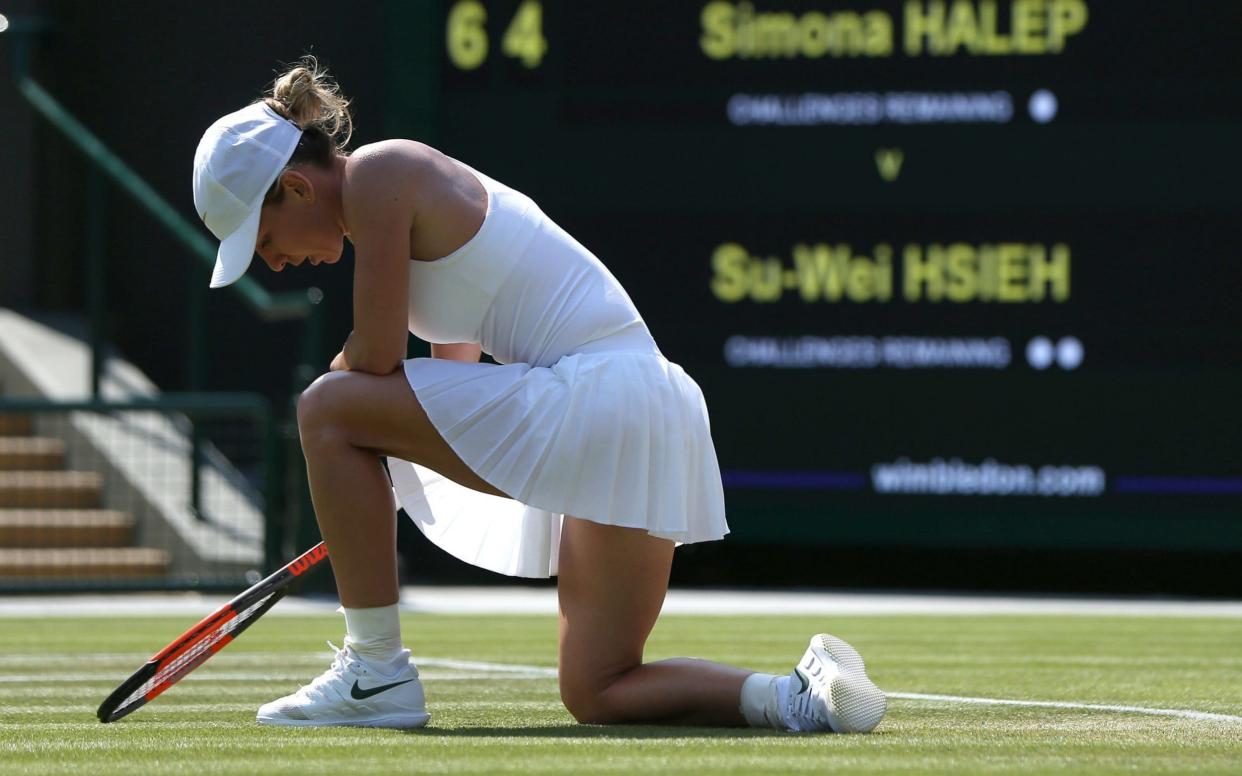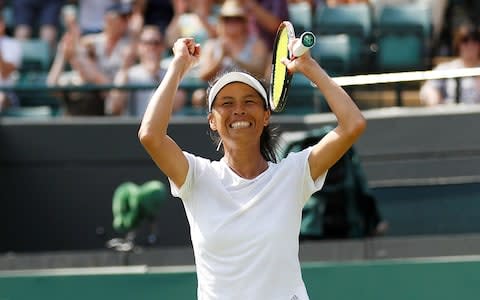Simona Halep crashes out of Wimbledon leaving Karolina Pliskova as only seed left from women's top 10

The “seeditis” plague spreading across the women’s draw claimed its most high profile victim yet – top seed Simona Halep.
As the seeds have scarpered throughout the first week, the world No 1 must have been eyeing up her chances of a second grand slam in a row as more and more likely.
But like many before her who have wilted under the pressure of adding “grand slam champion” to their repertoire, she was overcome by an inspired Su-Wei Hsieh of Taiwan, leaving Karolina Pliskova as the sole top 10 seed remaining in the draw.
Though Halep was pushed to three sets in the pair’s sole previous meeting on the tour in 2013, she would not have anticipated the stellar performance her opponent produced. In a match that saw 14 breaks of serve, nothing was guaranteed, but it seemed like the world No 1 was not attuned to this come the latter stages of the decider.
She wasted an opportunity to serve out the match at 5-3 in the final set, and then a match point later to give unseeded Hsieh a window to claw her way back to win 3-6, 6-4, 7-5.

Afterwards, Halep said an “unprofessional attitude” and mental tiredness meant she was unable to finish the job. “I just was too negative to myself, talking too much. I think because I’m tired, I couldn’t stay focused for every ball,” she said. “I was leading the match. I couldn’t stay focused to handle the pressure, the tension of the match.”
She gave credit to her opponent, saying Hsieh “deserved to win”, but from the outset the match looked like it could go either way.
It took six games before either player would hold their serve in the first set, and the constant back and forth was to be a sign of things to come for the Court No 1 crowd. It seemed like there was barely a game without a break point chance, of which there were 35 in total. Halep set up 23 of these, but would only convert 30 per cent of them.
Halep would go on to win the first set, but she never looked secure as Hsieh broke her to go up 3-1 in the second. Though Halep broke back, Hsieh seemed to always have an answer, and responded by breaking again and then serving out the set to force a decider.

Five more breaks would come, three from Hsieh, most significantly when Halep was serving for the match at 5-3. The Taiwanese’s inventive game challenged Halep no end, despite her best defensive efforts.
The Romanian found her opponent’s unconventional, two-handed forehand style difficult to predict, as the world No 48 expertly took the pace off powerful groundstrokes to place spinning drop-shots and send Halep stumbling to reach them.
She would regularly return to this play when facing break points, of which she saved an incredible 16. Halep would often have to send two or three would-be winners over the net before she’d shake off her 32-year-old opponent – and that was seldom. This was no more true than in the 21-shot rally in the final game of the match, where Hsieh pulled out a baseline winner from nowhere after being flung from corner to corner by an exasperated Halep.
She would keep her composure like a champion, saving two break points at 6-5 up, and winning on a second serve that Halep sent into the net. The crowd were completely behind the underdog, and their cheers provoked emotional tears of joy from the winner, in this only her third victory over a top 10 player in her entire career.
Ball boy and ball girls
Hsieh addressed her winning moment afterwards, saying she was afraid she would not be able to serve it out. “Last year I was play[ing] against [Lucie] Safarova, then I have two match points,” she said. “I make double-fault. Then she had one match point, [I] make double-fault again.” She said cheers from the crowd helped her to “cool down” and keep her serve in.
“Sometime can go good way, sometime not going good way,” she said of her style. “It’s important thing for me right now is I need to keep calm and keep concentrate on the court.
“In 5-2, against this big player, you could get smashed. It’s not easy. I just try to run as much as I can, try to catch every ball. I’m doing good.”
Hsieh seemed relaxed for a player going into her first ever second week at a grand slam, and she said she had not given a thought to winning – despite the draw opening up.
“I just try to enjoy the tennis and enjoy the city, enjoy the food,” she said. “I feel I’m really lucky to be a tennis player, stay here until the second week. I’m very, very grateful.”
The win means Hsieh will play her first fourth round at a grand slam against the unseeded Dominika Cibulkova on Tuesday.
Halep’s exit means that Pliskova is the sole survivor of the top 10 seeds going into the second week. Eleventh seed Angelique Kerber is the highest seed Serena Williams could possibly face in the final and, if she wasn’t already, the seven-time champion will be the favourite should she reach it.
Suarez Navarro adds to the casualties
Carla Suarez Navarro became the latest seed to be dumped out of Wimbledon in the first week after she was beaten by Switzerland’s Belinda Bencic.
Navarro, the 27th seed, was blown apart in the first set of her 6-1, 7-6 defeat by Bencic, a former top 10 player who has lost ground due to consistent struggles with injury.
Bencic has fallen to No 56 in the world as a result, but in the first round, she stunned the sixth seed, Caroline Garcia, with a straight-sets victory.
This is the second time Bencic has reached the fourth round of Wimbledon. She has enjoyed great success here as a junior, however, and won the girls’ singles title in 2013, the same year she won the French Open junior title.
Bencic will be tested again in the round of 16 as she comes up against Germany’s Angelique Kerber, who impressed in her comfortable 6-2, 6-4 victory over 18th seed Naomi Osaka.
Another seed to have been defeated was Australia’s Daria Gavrilova, the 26th seed, who succumbed to Aliaksandra Sasnovich, the world No 50. Gavrilova said she “played scared” in her 6-3, 6-1 loss. “I think mentally I wanted it too much,” she said. “I didn’t go after my shots. Next time I need to overcome that, because clearly playing scared does not win you matches.
“I was hitting the ball great in the warm-ups. I had the same routine. But I don’t know. I just did not go after my shots on court. I was not serving well. To be fair, I did not hit one shot clean. It was not good.”
On the men’s side, the experienced Gilles Simon needed five sets to get past Australia’s Matthew Ebden and set up a round of 16 meeting with Juan Martin del Potro, the fifth seed.
Simon, who reached the quarter-finals of Wimbledon in 2015, has slumped to world No 53 after a year in which he has lost 14 matches and won 19. At his peak, in 2009, Simon climbed as high as world No 6.
The Frenchman’s victory over Ebden, the world No 51, featured arguably the most exciting point of the tournament so far. The 17-shot rally, in the second set, included two drop shots, a diving volley and a stunning winner from the Australian, who had impressed in the opening round with a straight-sets victory over David Goffin, the 10th seed.
Kerber continues to operate in the shadows
For most players, this would have been a tricky assignment. Stepping onto Centre Court at just after 3.30pm as supporters swept for the exits to get an update on England's World Cup progress, Angelique Kerber would have been forgiven for feeling a little put out.
But Kerber is at her happiest when operating in the shadows. This is a player who won two grand slams in 2016 but experienced a severe case of vertigo once those successes had propelled her to the world No 1 spot. Kerber seemed weighed down by the 'world's best' tag, and has been liberated since retuning to the relative obscurity of the fringes around the top 10.
So it proved again as, with attention diverted elsewhere, Kerber produced an authoritative performance to take out the precocious No 18 seed Naomi Osaka 6-2, 6-4 in 63 minutes.
The problem Kerber faces now is that after the spate of first-week upsets, she is the second-highest seed left in the draw at No 11, as well as being a former finalist here. Expectations will surely start to rise, and the focus on her will intensify.
Not that the 30-year-old Kerber is taking much notice of the noise around her. "I'm just looking at my next match" she said. "You have to be ready for every single round. Especially at the grand slams, you have to play your best tennis every match.
"I have my eyes on what I'm doing and my matches."
Against Osaka, Kerber showed flashes of the durability that took her charging past Serena Williams and the rest of the field two years ago. She refused to let her far more powerful opponent dictate play - drawing gasps of approval from the Centre Crowd court with her Novak Djokovic-esque retrieval skills - and hit an impressive 23 winners herself.
Kerber plays the unseeded Belinda Bencic in the fourth round on Monday, and cannot meet a higher-ranked player until the final.
As for Osaka, 20, there was disappointment that a player being touted as the next big thing in women's tennis produced such an insipid display on her Centre Court debut.
Osaka, who has lived in America since the age of three but plays under the Japanese flag, said afterwards: "It was pretty bad. I could have enjoyed it more, being on Centre Court for the first time. To always see it on TV, to just go there and not really enjoy the moment, that's what I regret the most."

